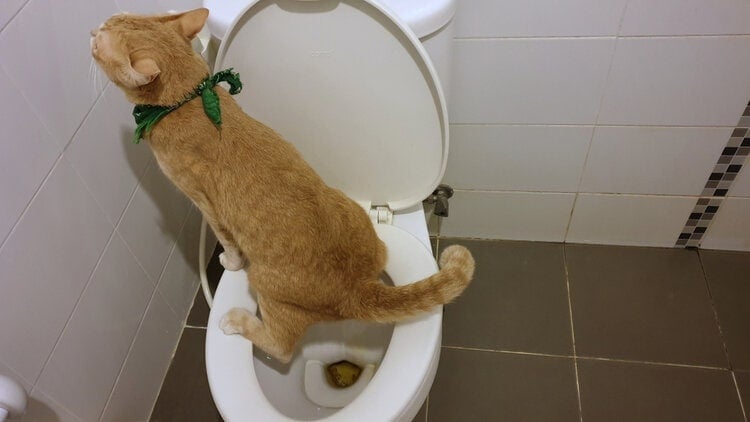The Risks of Flushing Cat Poop in Your Toilet - Preventive Steps
The Risks of Flushing Cat Poop in Your Toilet - Preventive Steps
Blog Article
Listed here below you can locate a bunch of reliable expertise related to Don’t flush cat feces down the toilet.

Introduction
As pet cat owners, it's important to bear in mind exactly how we deal with our feline close friends' waste. While it may seem practical to purge feline poop down the toilet, this practice can have destructive repercussions for both the environment and human wellness.
Alternatives to Flushing
Luckily, there are safer and extra accountable means to throw away cat poop. Take into consideration the complying with choices:
1. Scoop and Dispose in Trash
The most typical method of taking care of cat poop is to scoop it into an eco-friendly bag and throw it in the trash. Make sure to make use of a dedicated trash inside story and dispose of the waste quickly.
2. Usage Biodegradable Litter
Select eco-friendly pet cat clutter made from products such as corn or wheat. These clutters are eco-friendly and can be securely disposed of in the trash.
3. Hide in the Yard
If you have a backyard, take into consideration burying cat waste in an assigned area away from veggie gardens and water sources. Make certain to dig deep enough to avoid contamination of groundwater.
4. Mount a Pet Waste Disposal System
Invest in a pet dog waste disposal system specifically developed for feline waste. These systems utilize enzymes to break down the waste, minimizing smell and environmental influence.
Health Risks
Along with ecological worries, flushing feline waste can additionally posture health and wellness risks to people. Pet cat feces may consist of Toxoplasma gondii, a parasite that can trigger toxoplasmosis-- a possibly serious ailment, especially for expectant females and individuals with weakened body immune systems.
Ecological Impact
Purging cat poop introduces dangerous virus and bloodsuckers right into the water supply, positioning a considerable danger to water environments. These impurities can negatively affect aquatic life and concession water high quality.
Conclusion
Accountable family pet ownership extends past supplying food and shelter-- it additionally includes proper waste monitoring. By avoiding flushing feline poop down the toilet and going with alternate disposal approaches, we can reduce our ecological footprint and secure human health and wellness.
Why Can’t I Flush Cat Poop?
It Spreads a Parasite
Cats are frequently infected with a parasite called toxoplasma gondii. The parasite causes an infection called toxoplasmosis. It is usually harmless to cats. The parasite only uses cat poop as a host for its eggs. Otherwise, the cat’s immune system usually keeps the infection at low enough levels to maintain its own health. But it does not stop the develop of eggs. These eggs are tiny and surprisingly tough. They may survive for a year before they begin to grow. But that’s the problem.
Our wastewater system is not designed to deal with toxoplasmosis eggs. Instead, most eggs will flush from your toilet into sewers and wastewater management plants. After the sewage is treated for many other harmful things in it, it is typically released into local rivers, lakes, or oceans. Here, the toxoplasmosis eggs can find new hosts, including starfish, crabs, otters, and many other wildlife. For many, this is a significant risk to their health. Toxoplasmosis can also end up infecting water sources that are important for agriculture, which means our deer, pigs, and sheep can get infected too.
Is There Risk to Humans?
There can be a risk to human life from flushing cat poop down the toilet. If you do so, the parasites from your cat’s poop can end up in shellfish, game animals, or livestock. If this meat is then served raw or undercooked, the people who eat it can get sick.
In fact, according to the CDC, 40 million people in the United States are infected with toxoplasma gondii. They get it from exposure to infected seafood, or from some kind of cat poop contamination, like drinking from a stream that is contaminated or touching anything that has come into contact with cat poop. That includes just cleaning a cat litter box.
Most people who get infected with these parasites will not develop any symptoms. However, for pregnant women or for those with compromised immune systems, the parasite can cause severe health problems.
How to Handle Cat Poop
The best way to handle cat poop is actually to clean the box more often. The eggs that the parasite sheds will not become active until one to five days after the cat poops. That means that if you clean daily, you’re much less likely to come into direct contact with infectious eggs.
That said, always dispose of cat poop in the garbage and not down the toilet. Wash your hands before and after you clean the litter box, and bring the bag of poop right outside to your garbage bins.
https://trenchlesssolutionsusa.com/why-cant-i-flush-cat-poop/

Do you appreciate reading up on Don’t flush cat feces down the toilet? Put a remark down below. We would be pleased to find out your suggestions about this entry. In hopes that you visit us again soon. Do you know somebody else who is excited by the subject? Why not share it. We value reading our article about Don’t flush cat feces down the toilet.
Call Today Report this page